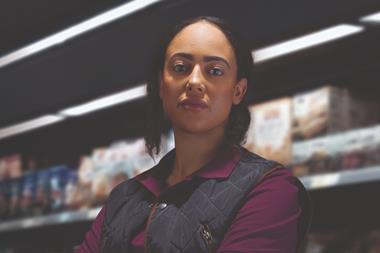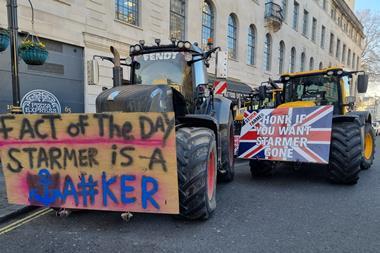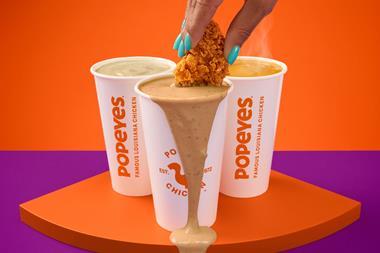The industry’s on red alert and vital questions need answers
but will we learn from sudan 1 >>>>
Mick Whitworth and Siân Harrington assess the damage to date - and explain what’s being done to prevent a repeat
The FSA announced it was setting up a task force to look at the issue of food contamination. This task force will be chaired by FSA chief executive Dr Jon Bell and involves representatives of the food industry, enforcement authorities and consumer organisations.
Its priority is to find ways of closing some of the gaps that have been exposed in the safety regime and it expects to report back on this in the autumn. The industry has welcomed the initiative. “Eighteen months is too long to wait to determine a proper, organised way of handling such matters. The task force is very useful in terms of the here and now,” says Food and Drink Federation deputy director general Martin Paterson.
Three months after Premier Foods found itself at the centre of the biggest food recall in UK history, any dust that has settled is coloured an unnaturally vivid red.
Far from fizzling out, concerns about the contamination of food ingredients by illegal, potentially cancer-causing dyes such as Sudan I and Para Red are growing. And despite well-developed quality assurance systems and certification of suppliers, major brand owners and normally dependable ingredient suppliers have been caught on the hop.
It was back in February that the Food Standards Agency warned the public to steer clear of 350 products “inadvertently contaminated” with Sudan 1, an illegal food dye.
The agency had already made a series of relatively low-profile recalls since summer 2003 when traces of Sudan 1 - a red dye used in solvents and polishes, and a potential carcinogen - were first detected in products containing chilli powder imported from India.
In this latest incident, however, Premier Foods had not only used a contaminated flavouring in its own Crosse & Blackwell Worcester sauce, it had sold the product on as an ingredient to numerous other processors. In doing so, it had attached the words ‘cancer risk’ to hundreds of branded and own-label products and pushed Sudan 1 on to every front page. The ensuing recall is estimated to have cost at least £100m. A trickle of Sudan 1 contamination cases has continued to emerge since then.
And the issue had barely retreated to the newspapers’ inside pages when, last month, traces of a second illegal dye, Para Red, were discovered in the seasoning mixes in two Old El Paso dinner kits, manufactured by General Mills.
This time, the immediate source of the contaminated spice was identified as Ramon Sabater, a Spanish supplier considered reputable by the UK food industry.
By mid May, 69 products containing traces of Para Red had been recalled. And other illegal colours are now emerging, notably Rhodamine B and Orange II, which were found this month in products in Germany and are thought to have arrived in chilli powder imported from Vietnam. So are these just the tip of the iceberg?
“There are hundreds of synthetic dyes out there,” says Simon Cripps, executive chairman of the Seasoning and Spice Association, whose members account for about £400m of ingredient sales to UK manufacturers. “So it’s a question of ‘where does it end?’, because you cannot be expected to test for every colour. That would be an impossibility.”
The same concern is expressed by Bob Foot, regulatory affairs manager at the European Snacks Association. “Sudan 1 has been detected and we are now readily testing for it. Now that it is out of the limelight, we’ve found Para Red. And we know there are more potentially waiting to come in. What others are out there?”
The fallout from the Sudan I crisis in Britain may already be causing primary suppliers to turn to atlernative dyes - and it is all too likely that there will be a 12 to 18-month time-lag before new substances are effectively covered by screening by European clients and regulatory bodies.
This means that there is an ongoing risk of uncleared and potentially illegal substances present in large volumes of spices and seasonings in the supply chain.
For this reason, manufacturers have been calling on the FSA to consider setting safe maximum residue levels for dyes such as Sudan 1 and Para Red, based on an assessment of the risk to health, rather than outlawing any product that carries the faintest traces of illegal dye.
But just a few weeks ago it was clear these calls were falling on deaf ears and that a major row was brewing between manufacturers deeply frustrated by the FSA’s then tough, zero-tolerance line on illegal dyes, and an agency that was equally unimpressed by manufacturers’ approaches.
According to its director of food safety, Andrew Wadge, the FSA was “clearly very disappointed” that the Sudan 1 crisis had arisen, “because since July 2003 we have consistently, and on a number of occasions, issued advice and warnings to the industry to check the quality and safety of spices”.
Meanwhile, the FSA’s handling of the situation has been much criticised for being over the top (see The Saturday Essay, p26). And, for legal reasons, it cannot even start an inquiry into the 2003 contamination incident for some 18 months. Who knows how long it will be before it can analyse this year’s scandals?
But this week the acrimonious atmosphere has suddenly been replaced by more conciliatory tones on both sides.
The reason? There are finally signs that a workable solution to prevent such scares in the future is on the horizon.
On top of this, the agency has issued new advice following a meeting in Brussels during which the European Commission asked the UK, Netherlands, France and Spain to agree on analytical methods for the current crop of illegal dyes, which would bring much-desired standardisation to testing methods. At this meeting the European Food Safety Authority (EFSA) agreed to carry out a risk assessment on toxicological data available on Para Red and other similar dyes.
While this work is going on, the FSA is recommending that the method for detecting Sudan 1 and Para Red should be based on High Performance Liquid Chromatography and that the limit of detection for this method will be 0.5-1.0mg/kg, or parts per million. This answers one of the key criticisms levelled against the FSA, that it had pursued a zero-tolerance approach and then just left the industry to get on with it. Without such advice, manufacturers did not know how to achieve best practice.
“It is the guidance that we have been seeking. We are pleased we now have that direction,” says Cripps. “And it is welcome that FSA and ESFA are working to harmonise risk assessment and testing methodology across Europe.”
He adds that the FSA has also responded positively to the Seasoning and Spice Association’s open doors initiative, which invites the FSA to visit any office or factory. “As a first step we will be working with the agency to conduct a joint survey on spices,” says Cripps.
The European Snacks Association is now asking Brussels to help manufacturers stamp out the contamination at source, by pressuring the governments of spice-growing nations to clean up their industries through legislation banning the use of illegal dyes.
Foot says: “This has to come from the Commission; food companies alone can’t do it.
“In the past, the Commission has worked with the Chinese authorities on veterinary drug residues in shellfish and with the Iranians on aflatoxin in pistachios. So there are previous examples.”
The FSA’s Wadge says any support the Commission can give is to be welcomed but he wants the ball to remain firmly in the manufacturing sector’s court.
He points out that, under general European food law, product safety is the clear responsibility of producers. “We have always made it clear that the risk is very low. But these are illegal carcinogens and consumers do not expect to be exposed to carcinogenic dyes.”
And he insists the Commission has made it “very clear” it regards Sudan 1 and Para Red as “both illegal and carcinogenic” and the FSA will firmly resist any softening of the enforcement regime.
Sudan 1 came from nowhere to catch Britain’s food industry unawares and embarrassed. What plainly emerges from events to date is that everyone has to work together - quickly, effectively, and in unity - to put the genie back in the bottle. For good.
A nice little earner?
>>multiples dismiss suggestions that recalls are profitable for them
Retailers have dismissed as “ridiculous” suggestions they have profited from the Sudan 1 and Para Red recalls through high charges to suppliers.
Jeremy Moore, European business development manager at RQA Europe, a global crisis management consultancy, said product recalls were now “very, very easy” for the big four grocers due to robust systems. He claimed: “They have also run recall as a bit of a profit centre.”
RQA works closely with AIG, one of the biggest providers of contaminated product insurance, advising clients on how to avoid and limit the impact of recalls.
Moore said one major retailer had charged suppliers an administration fee of £40,000 before it would start taking products off shelves, made a per-unit charge for any products withdrawn, and expected suppliers to provide price and promotional support to restore products to the shelves.
“The cynic in me says that, in some cases, they can make more money out of recalls than out of selling the products.”
His view was confirmed by the head of one manufacturing sector trade body, who said a £40,000 charge was “the norm” but added: “I’ve also heard that because the current situation is so unusual, the supermarkets are not necessarily doing that.”
But a Tesco spokeswoman said: “Any such suggestion is ridiculous. Our contracts with suppliers are always agreed upfront. We work hand in hand to avoid problems that lead to recalls and certainly would not attempt to profit from them.” The cost of the scares could not be measured solely in financial terms, she said. “Consumer confidence is our key measure.”
A Sainsbury spokeswoman said: “The cost of a withdrawal is not just about product cost. It’s about the man hours you spend making sure customers are confident. We would far rather make money by selling products.”
Name of the game: blame
Will Premier Foods be able to pass the buck to its suppliers and their insurers? How big a legal minefield is being opened up?
When Premier Foods presented its preliminary results on March 2, chief executive Robert Schofield was bullish. He told analysts: “Based on our assessment of claims and our insurance position, we believe the company does not have a material financial exposure.”
After an initial dip to 267p, Premier’s share price has recovered to 300p - roughly where it stood before February 18’s recall. And analysts say they are still not predicting any major damage to the business. “If something awful comes out in the future, and they say ‘our insurance doesn’t cover it, or not this amount’, it could affect the share price,” says Nicola Mallard at Investec Securities. “But I don’t think there’s any lasting impact.”
Sales of Crosse & Blackwell Worcester sauce, the affected brand, are worth £1m - a fraction of Premier’s £842m turnover. But its sale as an ingredient to other producers has led to an estimated recall cost of £100m-plus.
The majority of UK food firms are not insured for product recalls and, in any event, most contaminated product insurance policies exclude carcinogens such as Sudan 1.
According to solicitors representing those caught up in this incident, most manufacturers supplied, directly or indirectly, with contaminated ingredients from Premier Foods won’t be relying on insurance. Instead they will make contractual claims under civil law, either against Premier or against their immediate supplier. Each party - including Premier - will be trying to push the costs one stage up the chain. An insider at one major prepared foods business said: “We don’t know where this will stop, but we only dealt with Premier, and don’t need to look any further at the moment.”
Last week, a spokesman for Premier Foods said it was unable to discuss what compensation claims it had received, the extent of its own insurance or its own progress in recovering costs. According to solicitor Eversheds, which is advising a number of affected companies, loss adjusters instructed by Premier’s insurers and its auditor, Grant Thornton, have been touring the UK “verifying levels of quarantined stock and validating claims that have been submitted”.
If Premier faces regulatory or criminal proceedings, it might be able to use a due diligence defence if it can show it took all reasonable steps. But Eversheds’ head of product liability Richard Matthews believes the argument for affected customers to receive compensation under civil law is “clear cut”. “Was the product supplied fit for purpose and of satisfactory quality? Patently not. It’s not incumbent upon Premier’s customers to prove any negligence on Premier’s part.”
Companies will not just be looking at recovering product costs. According to Karen Goodburn, secretary-general of the Chilled Food Association, a chilled food withdrawal will cost £130,000 once all additional expenses, such as advertising, are taken into account.
David Williams, a partner in the product integrity team at Hammonds Solicitors, says: “The sort of claims include logistics costs, repackaging costs, management time, in-store costs such as wages for de-stocking, reduced cashflow, and external costs such as PR.”
A further issue, says Williams, is that many suppliers will have limitation of liability clauses, making it difficult for clients to recover the full cost of a recall. The multiples refuse to accept any limit on direct suppliers’ liability, but those further up the chain, with less buying clout, might find their claims capped. In these cases, says Williams, they might bypass their immediate supplier and make a claim against Premier for negligence.
but will we learn from sudan 1 >>>>
Mick Whitworth and Siân Harrington assess the damage to date - and explain what’s being done to prevent a repeat
The FSA announced it was setting up a task force to look at the issue of food contamination. This task force will be chaired by FSA chief executive Dr Jon Bell and involves representatives of the food industry, enforcement authorities and consumer organisations.
Its priority is to find ways of closing some of the gaps that have been exposed in the safety regime and it expects to report back on this in the autumn. The industry has welcomed the initiative. “Eighteen months is too long to wait to determine a proper, organised way of handling such matters. The task force is very useful in terms of the here and now,” says Food and Drink Federation deputy director general Martin Paterson.
Three months after Premier Foods found itself at the centre of the biggest food recall in UK history, any dust that has settled is coloured an unnaturally vivid red.
Far from fizzling out, concerns about the contamination of food ingredients by illegal, potentially cancer-causing dyes such as Sudan I and Para Red are growing. And despite well-developed quality assurance systems and certification of suppliers, major brand owners and normally dependable ingredient suppliers have been caught on the hop.
It was back in February that the Food Standards Agency warned the public to steer clear of 350 products “inadvertently contaminated” with Sudan 1, an illegal food dye.
The agency had already made a series of relatively low-profile recalls since summer 2003 when traces of Sudan 1 - a red dye used in solvents and polishes, and a potential carcinogen - were first detected in products containing chilli powder imported from India.
In this latest incident, however, Premier Foods had not only used a contaminated flavouring in its own Crosse & Blackwell Worcester sauce, it had sold the product on as an ingredient to numerous other processors. In doing so, it had attached the words ‘cancer risk’ to hundreds of branded and own-label products and pushed Sudan 1 on to every front page. The ensuing recall is estimated to have cost at least £100m. A trickle of Sudan 1 contamination cases has continued to emerge since then.
And the issue had barely retreated to the newspapers’ inside pages when, last month, traces of a second illegal dye, Para Red, were discovered in the seasoning mixes in two Old El Paso dinner kits, manufactured by General Mills.
This time, the immediate source of the contaminated spice was identified as Ramon Sabater, a Spanish supplier considered reputable by the UK food industry.
By mid May, 69 products containing traces of Para Red had been recalled. And other illegal colours are now emerging, notably Rhodamine B and Orange II, which were found this month in products in Germany and are thought to have arrived in chilli powder imported from Vietnam. So are these just the tip of the iceberg?
“There are hundreds of synthetic dyes out there,” says Simon Cripps, executive chairman of the Seasoning and Spice Association, whose members account for about £400m of ingredient sales to UK manufacturers. “So it’s a question of ‘where does it end?’, because you cannot be expected to test for every colour. That would be an impossibility.”
The same concern is expressed by Bob Foot, regulatory affairs manager at the European Snacks Association. “Sudan 1 has been detected and we are now readily testing for it. Now that it is out of the limelight, we’ve found Para Red. And we know there are more potentially waiting to come in. What others are out there?”
The fallout from the Sudan I crisis in Britain may already be causing primary suppliers to turn to atlernative dyes - and it is all too likely that there will be a 12 to 18-month time-lag before new substances are effectively covered by screening by European clients and regulatory bodies.
This means that there is an ongoing risk of uncleared and potentially illegal substances present in large volumes of spices and seasonings in the supply chain.
For this reason, manufacturers have been calling on the FSA to consider setting safe maximum residue levels for dyes such as Sudan 1 and Para Red, based on an assessment of the risk to health, rather than outlawing any product that carries the faintest traces of illegal dye.
But just a few weeks ago it was clear these calls were falling on deaf ears and that a major row was brewing between manufacturers deeply frustrated by the FSA’s then tough, zero-tolerance line on illegal dyes, and an agency that was equally unimpressed by manufacturers’ approaches.
According to its director of food safety, Andrew Wadge, the FSA was “clearly very disappointed” that the Sudan 1 crisis had arisen, “because since July 2003 we have consistently, and on a number of occasions, issued advice and warnings to the industry to check the quality and safety of spices”.
Meanwhile, the FSA’s handling of the situation has been much criticised for being over the top (see The Saturday Essay, p26). And, for legal reasons, it cannot even start an inquiry into the 2003 contamination incident for some 18 months. Who knows how long it will be before it can analyse this year’s scandals?
But this week the acrimonious atmosphere has suddenly been replaced by more conciliatory tones on both sides.
The reason? There are finally signs that a workable solution to prevent such scares in the future is on the horizon.
On top of this, the agency has issued new advice following a meeting in Brussels during which the European Commission asked the UK, Netherlands, France and Spain to agree on analytical methods for the current crop of illegal dyes, which would bring much-desired standardisation to testing methods. At this meeting the European Food Safety Authority (EFSA) agreed to carry out a risk assessment on toxicological data available on Para Red and other similar dyes.
While this work is going on, the FSA is recommending that the method for detecting Sudan 1 and Para Red should be based on High Performance Liquid Chromatography and that the limit of detection for this method will be 0.5-1.0mg/kg, or parts per million. This answers one of the key criticisms levelled against the FSA, that it had pursued a zero-tolerance approach and then just left the industry to get on with it. Without such advice, manufacturers did not know how to achieve best practice.
“It is the guidance that we have been seeking. We are pleased we now have that direction,” says Cripps. “And it is welcome that FSA and ESFA are working to harmonise risk assessment and testing methodology across Europe.”
He adds that the FSA has also responded positively to the Seasoning and Spice Association’s open doors initiative, which invites the FSA to visit any office or factory. “As a first step we will be working with the agency to conduct a joint survey on spices,” says Cripps.
The European Snacks Association is now asking Brussels to help manufacturers stamp out the contamination at source, by pressuring the governments of spice-growing nations to clean up their industries through legislation banning the use of illegal dyes.
Foot says: “This has to come from the Commission; food companies alone can’t do it.
“In the past, the Commission has worked with the Chinese authorities on veterinary drug residues in shellfish and with the Iranians on aflatoxin in pistachios. So there are previous examples.”
The FSA’s Wadge says any support the Commission can give is to be welcomed but he wants the ball to remain firmly in the manufacturing sector’s court.
He points out that, under general European food law, product safety is the clear responsibility of producers. “We have always made it clear that the risk is very low. But these are illegal carcinogens and consumers do not expect to be exposed to carcinogenic dyes.”
And he insists the Commission has made it “very clear” it regards Sudan 1 and Para Red as “both illegal and carcinogenic” and the FSA will firmly resist any softening of the enforcement regime.
Sudan 1 came from nowhere to catch Britain’s food industry unawares and embarrassed. What plainly emerges from events to date is that everyone has to work together - quickly, effectively, and in unity - to put the genie back in the bottle. For good.
A nice little earner?
>>multiples dismiss suggestions that recalls are profitable for them
Retailers have dismissed as “ridiculous” suggestions they have profited from the Sudan 1 and Para Red recalls through high charges to suppliers.
Jeremy Moore, European business development manager at RQA Europe, a global crisis management consultancy, said product recalls were now “very, very easy” for the big four grocers due to robust systems. He claimed: “They have also run recall as a bit of a profit centre.”
RQA works closely with AIG, one of the biggest providers of contaminated product insurance, advising clients on how to avoid and limit the impact of recalls.
Moore said one major retailer had charged suppliers an administration fee of £40,000 before it would start taking products off shelves, made a per-unit charge for any products withdrawn, and expected suppliers to provide price and promotional support to restore products to the shelves.
“The cynic in me says that, in some cases, they can make more money out of recalls than out of selling the products.”
His view was confirmed by the head of one manufacturing sector trade body, who said a £40,000 charge was “the norm” but added: “I’ve also heard that because the current situation is so unusual, the supermarkets are not necessarily doing that.”
But a Tesco spokeswoman said: “Any such suggestion is ridiculous. Our contracts with suppliers are always agreed upfront. We work hand in hand to avoid problems that lead to recalls and certainly would not attempt to profit from them.” The cost of the scares could not be measured solely in financial terms, she said. “Consumer confidence is our key measure.”
A Sainsbury spokeswoman said: “The cost of a withdrawal is not just about product cost. It’s about the man hours you spend making sure customers are confident. We would far rather make money by selling products.”
Name of the game: blame
Will Premier Foods be able to pass the buck to its suppliers and their insurers? How big a legal minefield is being opened up?
When Premier Foods presented its preliminary results on March 2, chief executive Robert Schofield was bullish. He told analysts: “Based on our assessment of claims and our insurance position, we believe the company does not have a material financial exposure.”
After an initial dip to 267p, Premier’s share price has recovered to 300p - roughly where it stood before February 18’s recall. And analysts say they are still not predicting any major damage to the business. “If something awful comes out in the future, and they say ‘our insurance doesn’t cover it, or not this amount’, it could affect the share price,” says Nicola Mallard at Investec Securities. “But I don’t think there’s any lasting impact.”
Sales of Crosse & Blackwell Worcester sauce, the affected brand, are worth £1m - a fraction of Premier’s £842m turnover. But its sale as an ingredient to other producers has led to an estimated recall cost of £100m-plus.
The majority of UK food firms are not insured for product recalls and, in any event, most contaminated product insurance policies exclude carcinogens such as Sudan 1.
According to solicitors representing those caught up in this incident, most manufacturers supplied, directly or indirectly, with contaminated ingredients from Premier Foods won’t be relying on insurance. Instead they will make contractual claims under civil law, either against Premier or against their immediate supplier. Each party - including Premier - will be trying to push the costs one stage up the chain. An insider at one major prepared foods business said: “We don’t know where this will stop, but we only dealt with Premier, and don’t need to look any further at the moment.”
Last week, a spokesman for Premier Foods said it was unable to discuss what compensation claims it had received, the extent of its own insurance or its own progress in recovering costs. According to solicitor Eversheds, which is advising a number of affected companies, loss adjusters instructed by Premier’s insurers and its auditor, Grant Thornton, have been touring the UK “verifying levels of quarantined stock and validating claims that have been submitted”.
If Premier faces regulatory or criminal proceedings, it might be able to use a due diligence defence if it can show it took all reasonable steps. But Eversheds’ head of product liability Richard Matthews believes the argument for affected customers to receive compensation under civil law is “clear cut”. “Was the product supplied fit for purpose and of satisfactory quality? Patently not. It’s not incumbent upon Premier’s customers to prove any negligence on Premier’s part.”
Companies will not just be looking at recovering product costs. According to Karen Goodburn, secretary-general of the Chilled Food Association, a chilled food withdrawal will cost £130,000 once all additional expenses, such as advertising, are taken into account.
David Williams, a partner in the product integrity team at Hammonds Solicitors, says: “The sort of claims include logistics costs, repackaging costs, management time, in-store costs such as wages for de-stocking, reduced cashflow, and external costs such as PR.”
A further issue, says Williams, is that many suppliers will have limitation of liability clauses, making it difficult for clients to recover the full cost of a recall. The multiples refuse to accept any limit on direct suppliers’ liability, but those further up the chain, with less buying clout, might find their claims capped. In these cases, says Williams, they might bypass their immediate supplier and make a claim against Premier for negligence.














No comments yet